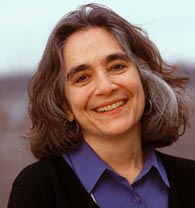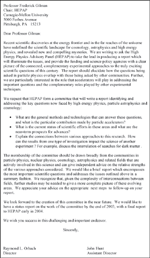|
What's a Nice Field Like Particle Physics Doing in a Universe Like This?
HEPAP committee will explain
by Judy Jackson
 | | Persis Drell, committee chair - Photo courtesy SLAC |
The quarks. The leptons. The bosons, the mesons, the hadrons, the
so-forth-and-so-ons. Not to mention the antiquarks, the antileptons and all their cousins and anticousins by the dozens....
The science of particle physics spent the 20th century discovering, in incredible depth and with amazing precision, the particles that make up the world and the forces that determine how it works. The result was the Standard Model, the theory that answered the question "What is the universe made of?"
Then they went and changed the universe.
Astrophysical and cosmological discoveries of the past few years have revealed the astonishing fact that the universe we thought we knew is only about five percent of what's out there. The rest, the other 95 percent, is....well, we don't know what it is. We call it dark matter and dark energy, for lack of any better terminology. Dark matter, we now know, is what's holding the universe together. Dark energy, we now know, is some unknown force that is driving it farther and farther apart.
In a revolution that some have compared to Copernicus's 16th century recognition that we aren't at the center of the solar system, we in our time have realized that we do not really know what our universe is made of. Science Magazine called the confirmation of a dark universe, the "Breakthrough of the Year" for 2003.
"Nothing's bigger than the universe," wrote Science Editor-in-Chief Donald Kennedy. "The question is what it's made of."
That's where particle physics comes in. Not that it ever really left.
What is the universe made of? Same question, new universe. What does this revolutionary new view of the cosmos mean for 21st-century particle physics?
A committee of the High Energy Physics Advisory Panel, appointed by HEPAP Chair Fred Gilman and led by Stanford Linear Collider Center physicist and Research Director Persis Drell, has spent the past five months working on a report that will explain what the field that brought you the Standard Model is doing in a universe of matter and energy unlike any we have ever seen before.
 | | (Click on thumbnail to view letter) |
"Recent scientific discoveries at the energy frontier and in the far reaches of the universe have redefined the scientific landscape for cosmology, astrophysics and high energy physics, and revealed new and compelling mysteries," wrote the Department of Energy and National Science Foundation officials responsible for U.S. particle physics research. "We are writing to ask the High Energy Physics Advisory Panel to take the lead in producing a report which will illuminate the issues, and provide the funding and science policy agencies with a clear picture of the connected, complementary experi-mental approaches to the truly exciting scientific questions of this century."
Drell said the report will articulate a set of questions that define the science of 21st-century particle physics and discuss how both current and future particle physics experiments can address those questions.
"This has been a great committee. The opportunity to collaborate with people from many different branches of physics has been a privilege. We have worked hard but also had a lot of fun. It is an exciting time in particle physics, and we hope that our report will help serve as a guide to where the search for understanding has taken us so far, and to where it is going."
Committee member and Fermilab theorist Joe Lykken described the group's work.
"It's been an interesting process," said Lykken, one of four Fermilab members of the committee. "We wanted to make clear that the questions particle physics has always asked have not changed, but that they have a revolutionary new meaning in the context of these recent discoveries about the nature of the universe."
The committee's report will be made public at a meeting of HEPAP in Washington, DC on April 18 and 19.
Committee Members
Persis Drell (Chair)
SLAC
Samuel Aronson
Brookhaven National Laboratory
Jonathan Bagger
John Hopkins University
Department of Physics & Astronomy
O. Keith Baker
Hampton University
Department of Physics
Neil Calder
SLAC
Fred Gilman
Carnegie Mellon University
Department of Physics
Judith G. Jackson
Fermilab
Edward W. Kolb
Fermilab
Joseph Lykken
Fermilab
Hitoshi Murayama
University of California at Berkeley
Physics Department
R. G. Hamish Robertson
University of Washington
Physics and Astronomy Department
James L. Siegrist
University of California at Berkeley
Physics Department
Simon P. Swordy
University of Chicago
Department of Physics
W. John Womersley
Fermilab

|

